Report on Transaction Exposure in International Finance
VerifiedAdded on 2023/06/15
|6
|890
|353
Report
AI Summary
This report provides an analysis of transaction exposure within the context of international finance, focusing on how fluctuations in foreign exchange rates impact a company's financial transactions. It examines the effects of these fluctuations on accounts receivable, accounts payable, and short-term assets, particularly when financial statements are reported in US dollars while significant portions of revenue and expenditures are transacted in other currencies such as Euro, Canadian dollar, Pound sterling, Swiss francs, and Mexican pesos. The report also discusses the use of hedging techniques to mitigate the adverse effects of currency fluctuations, although it acknowledges that not all transactions can be fully hedged. Furthermore, it highlights how the relative strength of the US dollar can lead to reduced values in US dollar terms for accounts receivable and short-term assets denominated in foreign currencies. The report concludes by emphasizing the importance of managing transaction exposure to maintain a stable financial position.
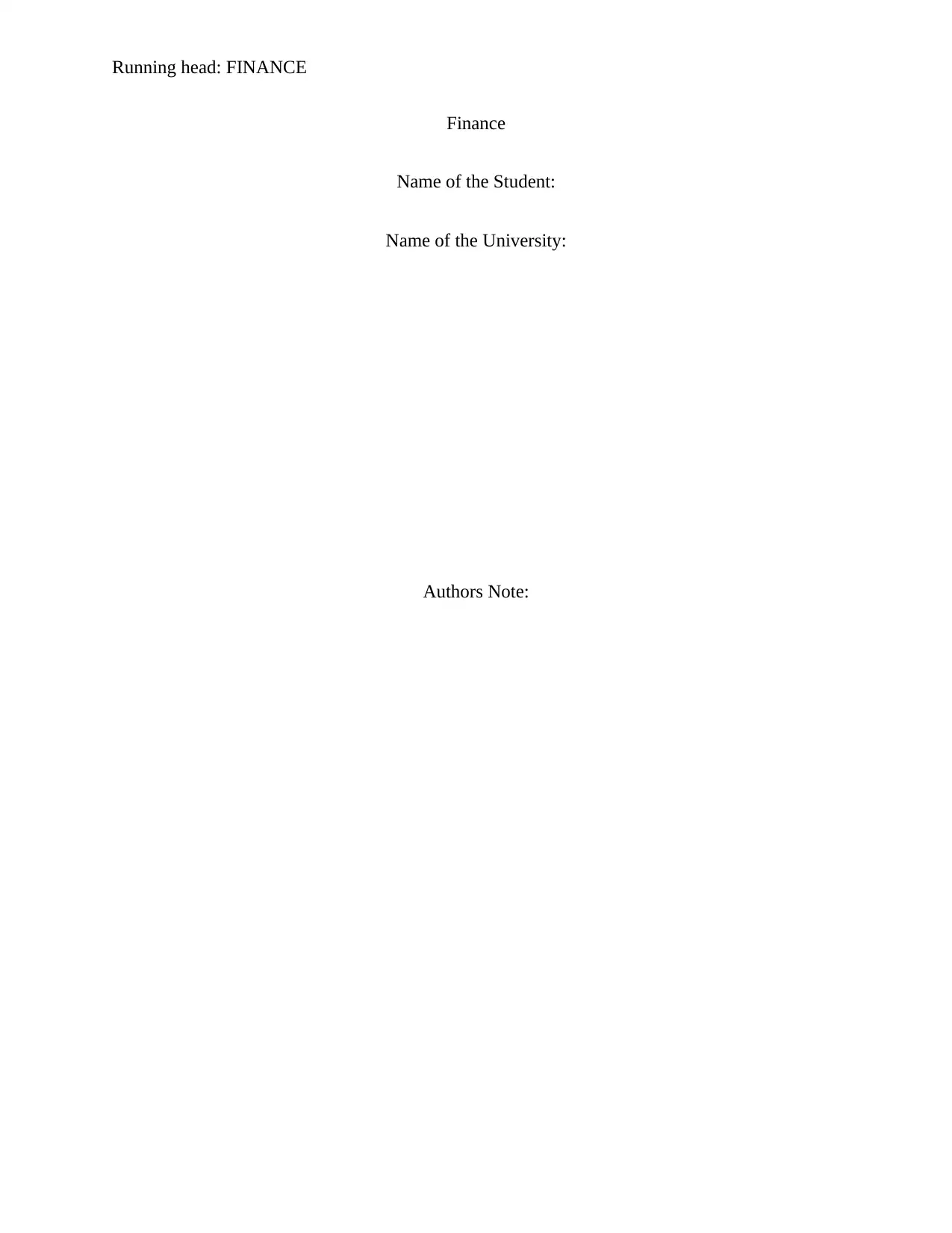
Running head: FINANCE
Finance
Name of the Student:
Name of the University:
Authors Note:
Finance
Name of the Student:
Name of the University:
Authors Note:
Paraphrase This Document
Need a fresh take? Get an instant paraphrase of this document with our AI Paraphraser
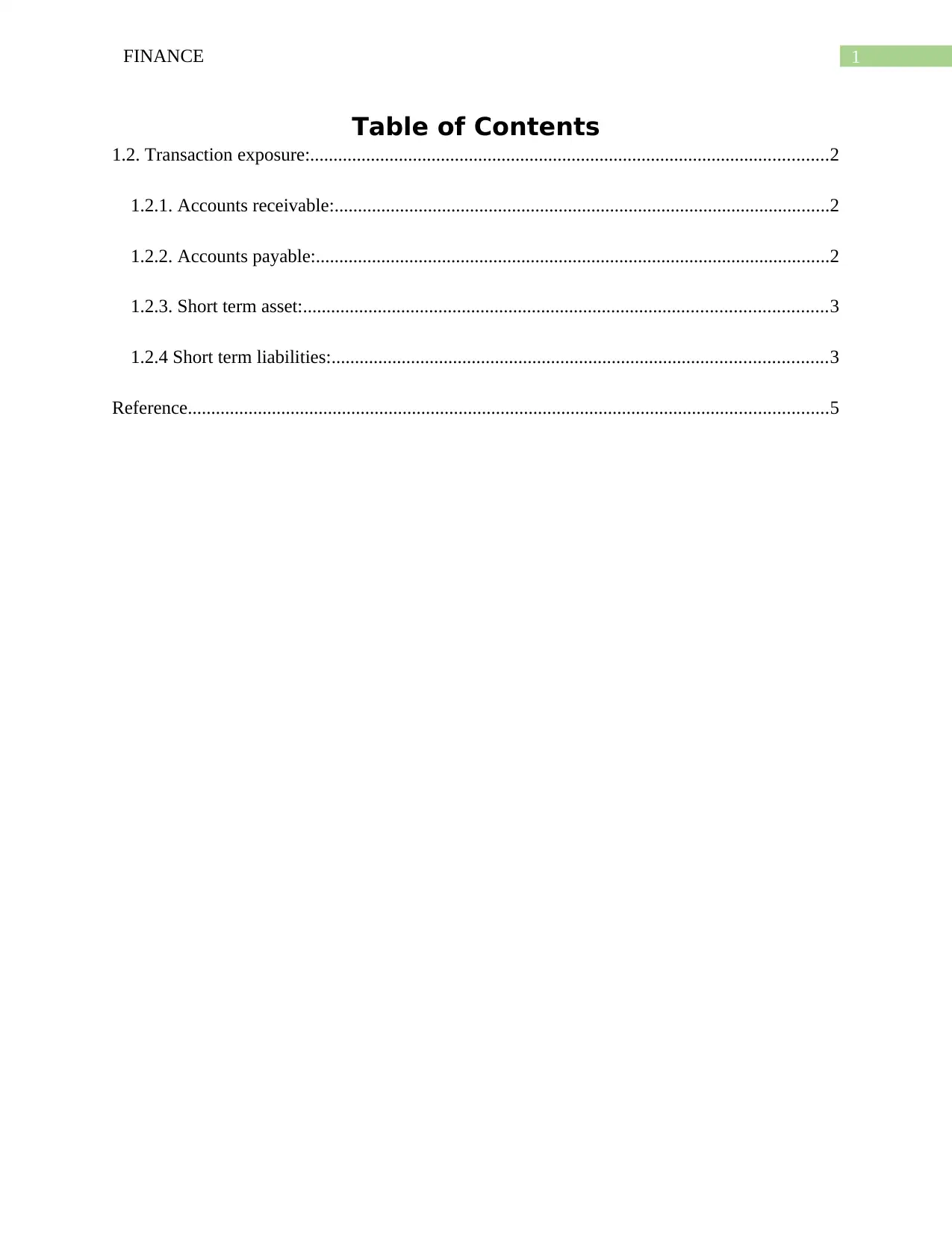
1FINANCE
Table of Contents
1.2. Transaction exposure:...............................................................................................................2
1.2.1. Accounts receivable:..........................................................................................................2
1.2.2. Accounts payable:..............................................................................................................2
1.2.3. Short term asset:................................................................................................................3
1.2.4 Short term liabilities:..........................................................................................................3
Reference.........................................................................................................................................5
Table of Contents
1.2. Transaction exposure:...............................................................................................................2
1.2.1. Accounts receivable:..........................................................................................................2
1.2.2. Accounts payable:..............................................................................................................2
1.2.3. Short term asset:................................................................................................................3
1.2.4 Short term liabilities:..........................................................................................................3
Reference.........................................................................................................................................5
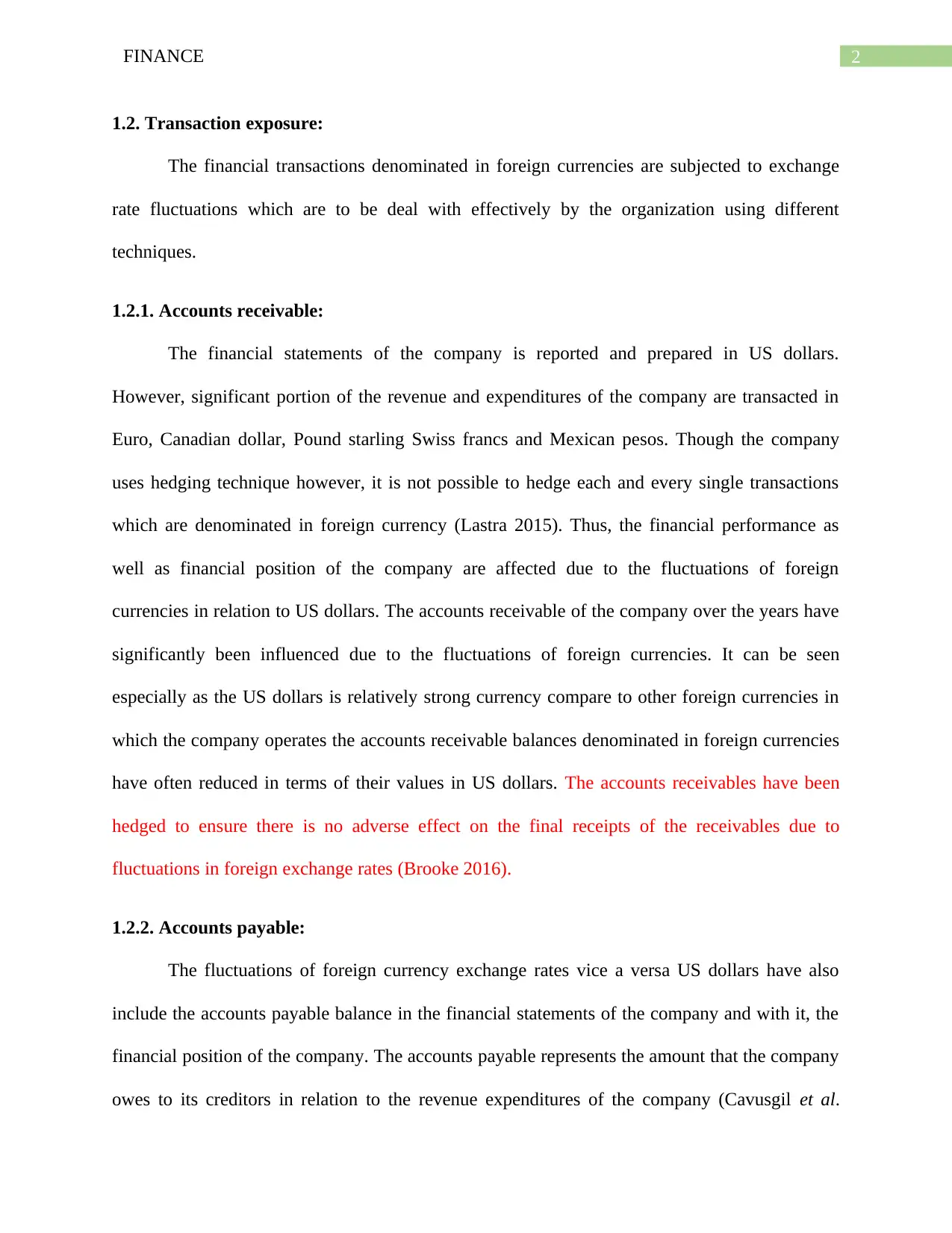
2FINANCE
1.2. Transaction exposure:
The financial transactions denominated in foreign currencies are subjected to exchange
rate fluctuations which are to be deal with effectively by the organization using different
techniques.
1.2.1. Accounts receivable:
The financial statements of the company is reported and prepared in US dollars.
However, significant portion of the revenue and expenditures of the company are transacted in
Euro, Canadian dollar, Pound starling Swiss francs and Mexican pesos. Though the company
uses hedging technique however, it is not possible to hedge each and every single transactions
which are denominated in foreign currency (Lastra 2015). Thus, the financial performance as
well as financial position of the company are affected due to the fluctuations of foreign
currencies in relation to US dollars. The accounts receivable of the company over the years have
significantly been influenced due to the fluctuations of foreign currencies. It can be seen
especially as the US dollars is relatively strong currency compare to other foreign currencies in
which the company operates the accounts receivable balances denominated in foreign currencies
have often reduced in terms of their values in US dollars. The accounts receivables have been
hedged to ensure there is no adverse effect on the final receipts of the receivables due to
fluctuations in foreign exchange rates (Brooke 2016).
1.2.2. Accounts payable:
The fluctuations of foreign currency exchange rates vice a versa US dollars have also
include the accounts payable balance in the financial statements of the company and with it, the
financial position of the company. The accounts payable represents the amount that the company
owes to its creditors in relation to the revenue expenditures of the company (Cavusgil et al.
1.2. Transaction exposure:
The financial transactions denominated in foreign currencies are subjected to exchange
rate fluctuations which are to be deal with effectively by the organization using different
techniques.
1.2.1. Accounts receivable:
The financial statements of the company is reported and prepared in US dollars.
However, significant portion of the revenue and expenditures of the company are transacted in
Euro, Canadian dollar, Pound starling Swiss francs and Mexican pesos. Though the company
uses hedging technique however, it is not possible to hedge each and every single transactions
which are denominated in foreign currency (Lastra 2015). Thus, the financial performance as
well as financial position of the company are affected due to the fluctuations of foreign
currencies in relation to US dollars. The accounts receivable of the company over the years have
significantly been influenced due to the fluctuations of foreign currencies. It can be seen
especially as the US dollars is relatively strong currency compare to other foreign currencies in
which the company operates the accounts receivable balances denominated in foreign currencies
have often reduced in terms of their values in US dollars. The accounts receivables have been
hedged to ensure there is no adverse effect on the final receipts of the receivables due to
fluctuations in foreign exchange rates (Brooke 2016).
1.2.2. Accounts payable:
The fluctuations of foreign currency exchange rates vice a versa US dollars have also
include the accounts payable balance in the financial statements of the company and with it, the
financial position of the company. The accounts payable represents the amount that the company
owes to its creditors in relation to the revenue expenditures of the company (Cavusgil et al.
⊘ This is a preview!⊘
Do you want full access?
Subscribe today to unlock all pages.

Trusted by 1+ million students worldwide
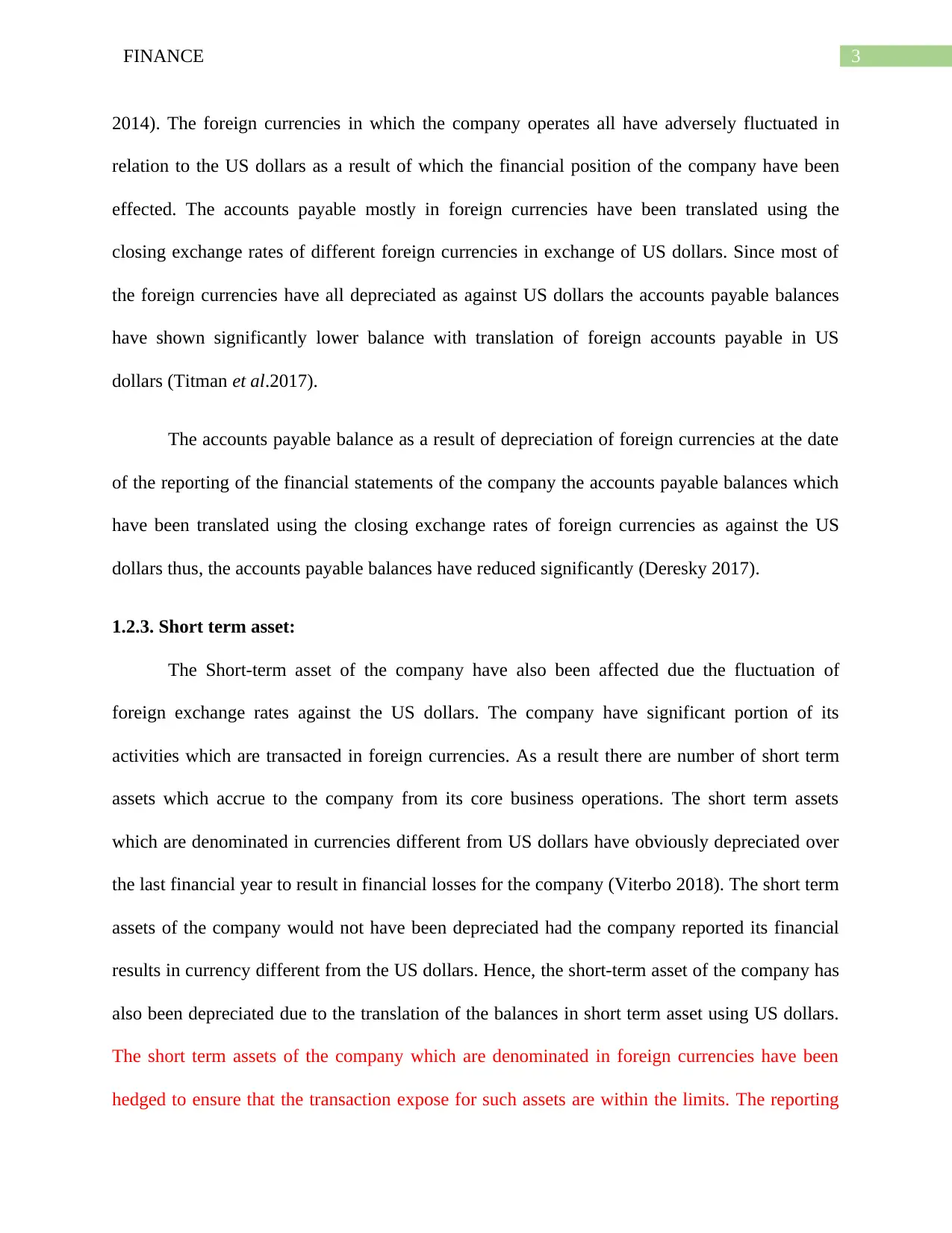
3FINANCE
2014). The foreign currencies in which the company operates all have adversely fluctuated in
relation to the US dollars as a result of which the financial position of the company have been
effected. The accounts payable mostly in foreign currencies have been translated using the
closing exchange rates of different foreign currencies in exchange of US dollars. Since most of
the foreign currencies have all depreciated as against US dollars the accounts payable balances
have shown significantly lower balance with translation of foreign accounts payable in US
dollars (Titman et al.2017).
The accounts payable balance as a result of depreciation of foreign currencies at the date
of the reporting of the financial statements of the company the accounts payable balances which
have been translated using the closing exchange rates of foreign currencies as against the US
dollars thus, the accounts payable balances have reduced significantly (Deresky 2017).
1.2.3. Short term asset:
The Short-term asset of the company have also been affected due the fluctuation of
foreign exchange rates against the US dollars. The company have significant portion of its
activities which are transacted in foreign currencies. As a result there are number of short term
assets which accrue to the company from its core business operations. The short term assets
which are denominated in currencies different from US dollars have obviously depreciated over
the last financial year to result in financial losses for the company (Viterbo 2018). The short term
assets of the company would not have been depreciated had the company reported its financial
results in currency different from the US dollars. Hence, the short-term asset of the company has
also been depreciated due to the translation of the balances in short term asset using US dollars.
The short term assets of the company which are denominated in foreign currencies have been
hedged to ensure that the transaction expose for such assets are within the limits. The reporting
2014). The foreign currencies in which the company operates all have adversely fluctuated in
relation to the US dollars as a result of which the financial position of the company have been
effected. The accounts payable mostly in foreign currencies have been translated using the
closing exchange rates of different foreign currencies in exchange of US dollars. Since most of
the foreign currencies have all depreciated as against US dollars the accounts payable balances
have shown significantly lower balance with translation of foreign accounts payable in US
dollars (Titman et al.2017).
The accounts payable balance as a result of depreciation of foreign currencies at the date
of the reporting of the financial statements of the company the accounts payable balances which
have been translated using the closing exchange rates of foreign currencies as against the US
dollars thus, the accounts payable balances have reduced significantly (Deresky 2017).
1.2.3. Short term asset:
The Short-term asset of the company have also been affected due the fluctuation of
foreign exchange rates against the US dollars. The company have significant portion of its
activities which are transacted in foreign currencies. As a result there are number of short term
assets which accrue to the company from its core business operations. The short term assets
which are denominated in currencies different from US dollars have obviously depreciated over
the last financial year to result in financial losses for the company (Viterbo 2018). The short term
assets of the company would not have been depreciated had the company reported its financial
results in currency different from the US dollars. Hence, the short-term asset of the company has
also been depreciated due to the translation of the balances in short term asset using US dollars.
The short term assets of the company which are denominated in foreign currencies have been
hedged to ensure that the transaction expose for such assets are within the limits. The reporting
Paraphrase This Document
Need a fresh take? Get an instant paraphrase of this document with our AI Paraphraser

4FINANCE
currency of the company being US dollar which is one of the strongest currencies across the
globe has certainly helped the company to pay off its short term liabilities from the collection of
the short term assets denominated in foreign currencies.
currency of the company being US dollar which is one of the strongest currencies across the
globe has certainly helped the company to pay off its short term liabilities from the collection of
the short term assets denominated in foreign currencies.
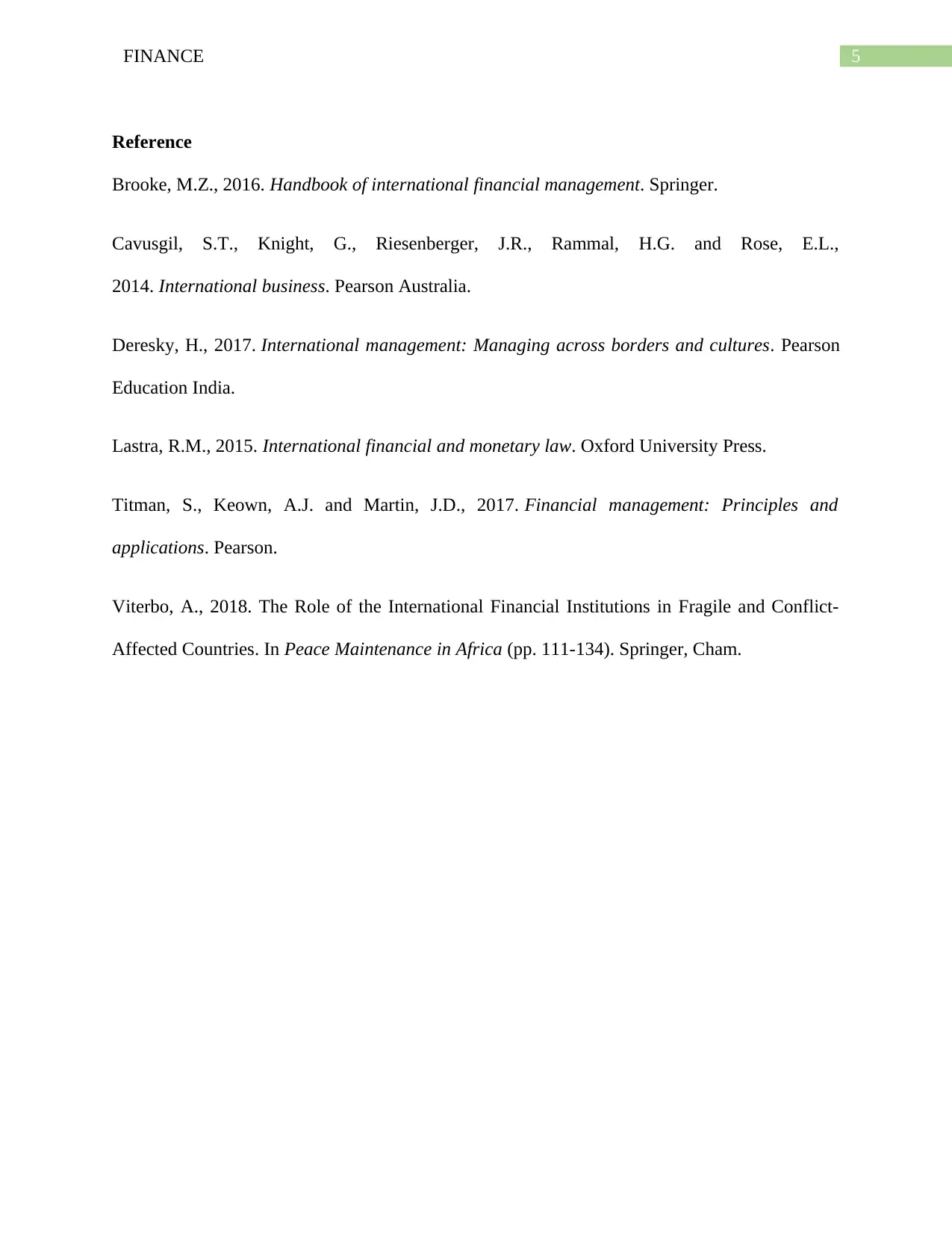
5FINANCE
Reference
Brooke, M.Z., 2016. Handbook of international financial management. Springer.
Cavusgil, S.T., Knight, G., Riesenberger, J.R., Rammal, H.G. and Rose, E.L.,
2014. International business. Pearson Australia.
Deresky, H., 2017. International management: Managing across borders and cultures. Pearson
Education India.
Lastra, R.M., 2015. International financial and monetary law. Oxford University Press.
Titman, S., Keown, A.J. and Martin, J.D., 2017. Financial management: Principles and
applications. Pearson.
Viterbo, A., 2018. The Role of the International Financial Institutions in Fragile and Conflict-
Affected Countries. In Peace Maintenance in Africa (pp. 111-134). Springer, Cham.
Reference
Brooke, M.Z., 2016. Handbook of international financial management. Springer.
Cavusgil, S.T., Knight, G., Riesenberger, J.R., Rammal, H.G. and Rose, E.L.,
2014. International business. Pearson Australia.
Deresky, H., 2017. International management: Managing across borders and cultures. Pearson
Education India.
Lastra, R.M., 2015. International financial and monetary law. Oxford University Press.
Titman, S., Keown, A.J. and Martin, J.D., 2017. Financial management: Principles and
applications. Pearson.
Viterbo, A., 2018. The Role of the International Financial Institutions in Fragile and Conflict-
Affected Countries. In Peace Maintenance in Africa (pp. 111-134). Springer, Cham.
⊘ This is a preview!⊘
Do you want full access?
Subscribe today to unlock all pages.

Trusted by 1+ million students worldwide
1 out of 6
Related Documents
Your All-in-One AI-Powered Toolkit for Academic Success.
+13062052269
info@desklib.com
Available 24*7 on WhatsApp / Email
![[object Object]](/_next/static/media/star-bottom.7253800d.svg)
Unlock your academic potential
Copyright © 2020–2025 A2Z Services. All Rights Reserved. Developed and managed by ZUCOL.





